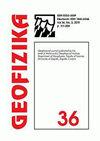An intermediate complexity AGCM simulations of climate response to a doubling of atmospheric carbon dioxide
IF 1.1
4区 地球科学
Q4 GEOCHEMISTRY & GEOPHYSICS
引用次数: 0
Abstract
Atmospheric response to doubled carbon dioxide concentration is estimated by analyzing 35-member ensemble mean made by an atmospheric general circulation model of intermediate complexity. Simulated changes in the mean fields are evaluated for winter (January-February-March) and summer (July-AugustSeptember) seasons. Results show that doubled CO2 concentration causes warming of around 2 °C at all levels in the model. At the surface, the largest temperature change is found over the polar areas; while at the higher levels considerable warming is found mostly over the continental parts. Atmospheric warming at the 300 hPa level is accompanied by cooling over the polar areas. At the levels above 300 hPa, temperature drops globally. Changes in jet stream occur at Northern Hemisphere with larger winter amplitudes. During the respective winter, stratiform precipitation significantly increases at the higher latitudes of both hemispheres and decreases mostly over the oceans. Over the Northern Hemisphere, convective precipitation is significantly increased during the summer. Over the southern part of tropical Pacific, stratiform and convective precipitation is decreased during the both seasons. Results also demonstrate that indirect impact of increased CO2 concentration (i.e. effects associated with changes in the lower boundary conditions) generally has a stronger contribution to the tropospheric warming than direct CO2 impact (i.e. the impact associated with absorption and emission of longwave radiation).中等复杂度AGCM模拟大气二氧化碳翻倍的气候响应
通过分析中等复杂程度大气环流模式的35元集合平均值,估算了大气对二氧化碳浓度加倍的响应。对冬季(1 - 2 - 3月)和夏季(7 - 8 - 9月)季节平均场的模拟变化进行了评估。结果表明,二氧化碳浓度加倍会导致模型中所有水平的升温约2°C。在地表,最大的温度变化出现在极地地区;而在较高的纬度上,相当大的变暖主要发生在大陆部分。300千帕水平的大气变暖伴随着极地地区的变冷。当温度高于300hpa时,全球温度下降。急流的变化发生在北半球,冬季振幅较大。在各自的冬季,层状降水在两个半球的高纬度地区显著增加,而在海洋上空则主要减少。在北半球,夏季对流降水显著增加。在热带太平洋南部,两个季节的层状降水和对流降水都有所减少。结果还表明,CO2浓度增加的间接影响(即与下边界条件变化有关的影响)通常比CO2的直接影响(即与长波辐射的吸收和发射有关的影响)对对流层变暖的贡献更大。
本文章由计算机程序翻译,如有差异,请以英文原文为准。
求助全文
约1分钟内获得全文
求助全文
来源期刊

Geofizika
地学-地球化学与地球物理
CiteScore
1.60
自引率
0.00%
发文量
17
审稿时长
>12 weeks
期刊介绍:
The Geofizika journal succeeds the Papers series (Radovi), which has been published since 1923 at the Geophysical Institute in Zagreb (current the Department of Geophysics, Faculty of Science, University of Zagreb).
Geofizika publishes contributions dealing with physics of the atmosphere, the sea and the Earth''s interior.
 求助内容:
求助内容: 应助结果提醒方式:
应助结果提醒方式:


